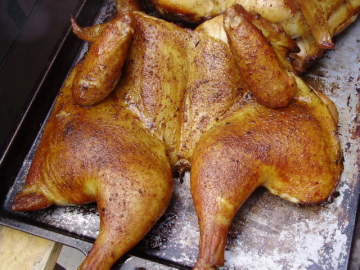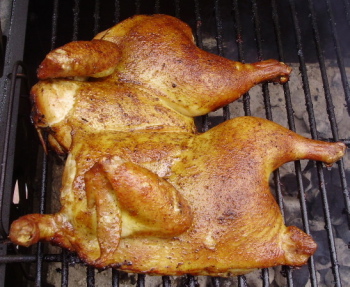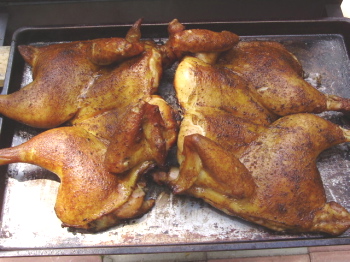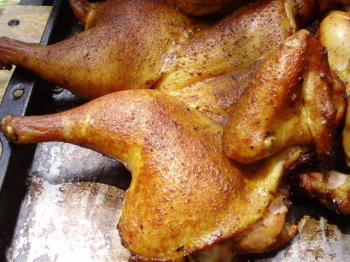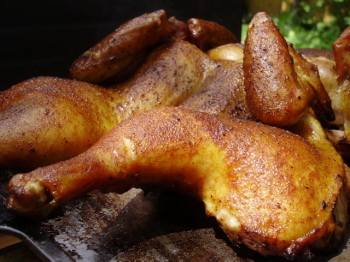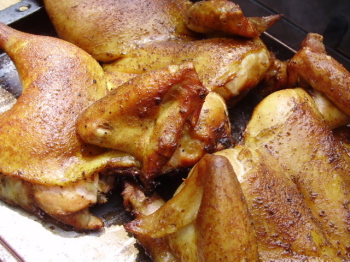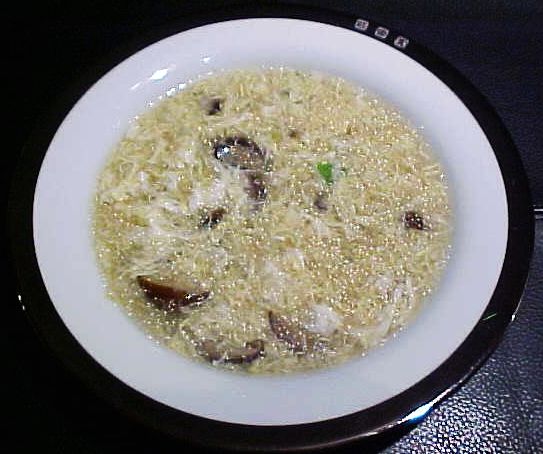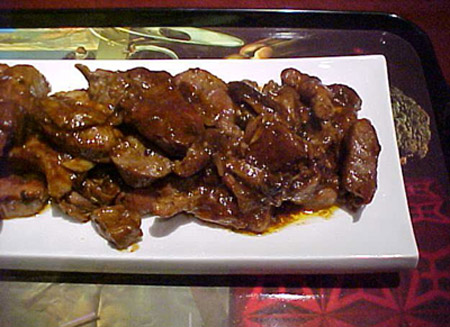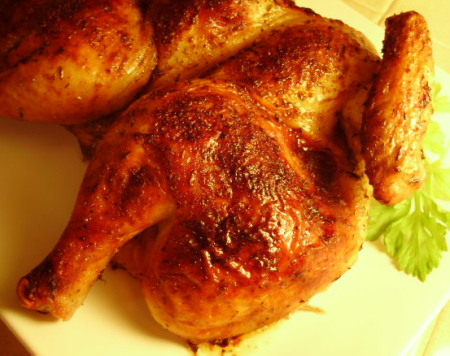Beautiful Brined Birds
Having never brined anything before, I used to wonder what all the fuss was about. I am now a believer!
Beautiful Brined Birds
Two things contributed to my introduction to brining: opportunity and time.
For Mother’s Day, mom asked me to “cook some chickens.” In the past, I’d brought “some chickens” prepared in a variety of ways, most in manners that would at least compliment, if not totally mesh with, the rest of the grilled/smoked/barbequed meats that would be present. Ever the traditionalist, mom liked the more straightforward preparations, dismissing the more esoteric (balsamic/herbed/fruited) with “that’s okay.”
So my self-imposed challenge was to produce better than “okay” chicken, but to also stay true to the simple, basic method that mom and dad both have taught me: don’t mess with it too much.
Brining intrigues me every Thanksgiving and Christmas, and every time Alton Brown’s Brined Pork Chops episode comes on. But I’ve never done it. Why? I don’t know. Perhaps I have been too busy messing with my other tried and true methods to think about doing something different. But tried and true was NOT what I was going for this time. Aha, opportunity!
Here I was, the Friday before Mother’s Day, with two nice, plump chickens, the ultimate Blank Canvas, in my fridge. But would I have time? A quick internet search yielded a multitude of brining times, based on weight, concentration of salt, etc. Time, it would seem, was on my side! But did I have the proper equipment? Water – check. Kosher salt – check. Sugar – check. Other optional ingredients were also on hand. But what about a suitable container? On cue, the cabinet door holding back our mountain of plastic containers swung open and spewed forth a 2.4 liter plastic food storage container. WITH LID! Brining, it would seem, was in the stars!
Brining employs two scientific principles, osmosis and diffusion. Somewhere in the deep recesses of my brain, I recalled hearing about these in high school Physical Science class. Basically, it’s all about balance. The meat, with a lesser concentration of water, salt, and flavorings, is immersed in a liquid bath with a higher concentration of water, salt and flavorings. To achieve balance, the water, salt and flavorings will move into the cells of the meat (this is the law of diffusion; the process is osmosis). Once in the meat, the salt and sugar react with the cells, and once exposed to heat, they “hang onto” the water, creating a naturally moister meat. Whew. All that was going to be happening in my refrigerator!
For my first brining, I decided to stick with the most common ratio of salt to water: 1 cup to 1 gallon. Kosher salt, the preferred type of salt, has a larger size crystal and is less “salty” than table salt; thus more of it is used than table salt. However, other factors come into play regarding the ratio – a longer brining time requires less salt, a shorter time requires more. Sugar also was important in a basic brine; I added 1/2 cup to the gallon of water. Four bay leaves, 2 tablespoons black peppercorns and a half head of garlic finished off my brine.
Butterflying whole chickens is my preferred way of roasting and grilling; I decided this was the best way to brine them as well. Two 4.5 pound split birds fit perfectly in the aforementioned plastic container along with the gallon of brine. I made sure to completely dissolve the salt and sugar in the liquid, then chilled it in the refrigerator for a couple of hours before introducing the chickens. They spent the night in the brine for about 8 hours.
The next day, after starting the charcoal grill, I drained and rinsed off the chickens. They looked remarkably plain, given the promise of culinary deliciousness. I patted them dry, then seasoned with freshly cracked black pepper and some Penzey’s Old World Seasoning (which I LOVE on roasted chicken). I drizzled some olive on them to moisten and help the seasoning adhere.
I put the chickens on the grill, then wondered how else I was going to “treat” them. I liked the idea of a basting sauce, but did not want anything strong or cloying, like barbeque sauces. I then remembered how wonderful and basic lemon juice and Worcestershire sauce was on chicken. Our old friend from the restaurant, Bea, used to roast chicken with that combination, which yielded a flavorful, moist bird (see “Bea’s Chicken”). I heated vegetable oil, butter, Worcestershire, lemon (juice and hulls), garlic, and hot sauce in a saucepan and used it to mop the birds. The flareups were beautiful, the aroma intoxicating, and I somehow knew the result was going to be delicious!
Total cooking time was about an hour and a half. I did not turn the chickens, leaving them skin side up the entire time. I did move them away from the “hot spot” for the last half hour of cooking. I considered flipping them to sear the skin, but didn’t want to risk tearing the skin. I am glad I didn’t, because the skin roasted up a lovely golden brown, and helped keep the meat moist and tender.
The result was amazingly delicious. The meat was juicy and tender, and the flavor was wonderful. I truly felt the natural chicken flavor was enhanced, without any sort of overwhelming outside flavor or seasoning; you really tasted chicken – not salt, not garlic, not herbs or anything else. Incredible! The flavor and texture also met with the approval of my harshest critic – my mom. She loved it!
Needless to say, I’ll be brining again. I’d like to try pork (surprise surprise) next, but will never hesitate to brine chicken. And I might not wait until Thanksgiving to try out a turkey!
And no, there aren’t any “after” pictures; it was all gone before I could take any!
PS: I threw the chicken giblets alongside the chickens, then tossed them in the basting sauce! A fantastic cook’s treat!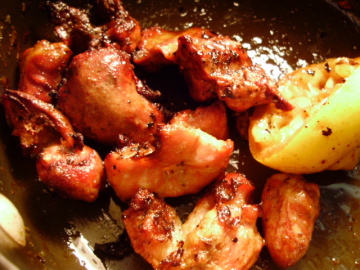 >
>
